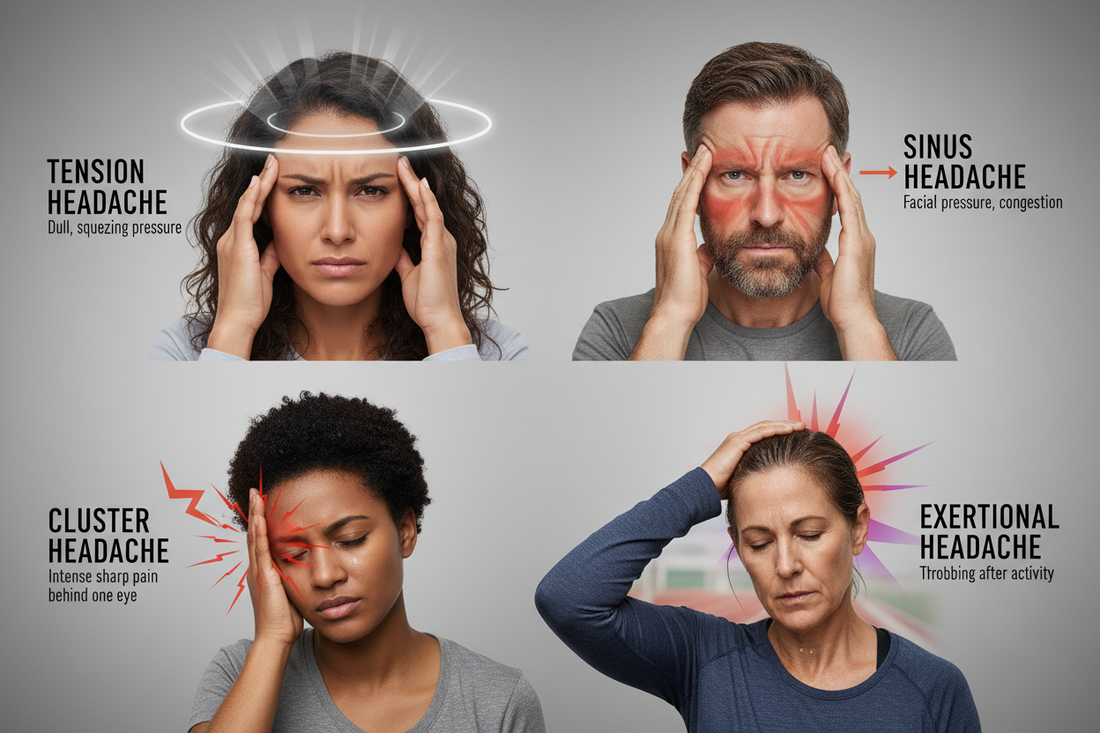
Migraine or Just a Headache? Know the Key Differences
Share
Almost everyone has experienced a headache — that dull, throbbing, or tightening sensation that makes it hard to think or focus. But when the pain becomes intense, pulsating, and often affects one side of the head along with nausea or light sensitivity, it might not be an ordinary headache — it could be a migraine.
Headaches are among the most common health complaints worldwide, affecting people of all ages. However, migraines represent a distinct neurological condition that involves a more complex set of symptoms and triggers. Understanding the difference between the two can help in managing symptoms effectively and preventing future episodes.
This article explores how to distinguish migraines from regular headaches, their causes, symptoms, triggers, and available treatment options — so you can identify what you’re dealing with and take the right action.
1. What Is a Headache?
A headache refers to any form of pain or discomfort in the head, scalp, or neck region. It can range from mild to severe and may last anywhere from a few minutes to several days.
Most headaches are primary headaches, meaning they are not caused by another medical condition. These include tension headaches, migraine headaches, and cluster headaches. Others are secondary headaches, which occur due to another underlying issue such as sinus infection, dehydration, or high blood pressure.
Common Types of Headaches
- Tension Headache: The most common type, characterized by a dull, squeezing pressure around the forehead or the back of the head.
- Sinus Headache: Caused by inflammation of the sinuses; pain is often felt in the cheeks, forehead, and around the eyes.
- Cluster Headache: Severe headaches occurring in cyclical patterns or clusters, often centered around one eye.
- Exertional Headache: Triggered by intense physical activity such as running or weightlifting.
Headaches generally respond to rest, hydration, or simple relaxation techniques and are not always severe enough to disrupt daily life.
2. What Is a Migraine?
A migraine is more than just a headache — it’s a neurological condition characterized by recurrent, severe head pain and a range of other symptoms. Migraines often involve intense throbbing or pulsing pain, usually on one side of the head, and can last for hours or even days.
Migraines affect the nervous system and blood vessels, leading to a chain of changes in brain activity, blood flow, and nerve signaling. They are often accompanied by nausea, vomiting, and heightened sensitivity to light, sound, or smells.
According to the World Health Organization (WHO), migraines rank among the top 10 most disabling medical conditions globally.
3. The Key Differences Between a Headache and a Migraine
While both cause head pain, several factors clearly differentiate migraines from regular headaches.

4. Phases of a Migraine Attack
Migraines often occur in stages, with specific signs that can help identify them early:
1. Prodrome Phase (Early Warning Signs)
This phase occurs hours or even a day before the migraine attack.
Symptoms include:
- Mood changes (irritability or depression)
- Fatigue or yawning frequently
- Food cravings
- Increased thirst or urination
- Neck stiffness
2. Aura Phase (for some people)
About 20–25% of migraine sufferers experience an aura — a series of neurological symptoms that appear before or during the headache phase.
Common aura symptoms include:
- Visual disturbances (flashes of light, zigzag lines, or blind spots)
- Tingling in the face or hands
- Temporary speech difficulty
3. Headache Phase
The pain begins gradually and becomes intense.
Typical characteristics:
- Throbbing or pulsating pain (often one-sided)
- Sensitivity to light, sound, or smell
- Nausea and vomiting
- Pain worsens with movement
4. Postdrome Phase (Recovery)
After the pain subsides, you may feel drained, confused, or weak for up to a day — often described as a “migraine hangover.”
5. Common Triggers for Migraine and Headache
Understanding what sets off your pain is crucial to managing it effectively.
Headache Triggers
- Stress or anxiety
- Dehydration
- Lack of sleep
- Skipped meals
- Poor posture
- Eyestrain (especially from screens)
Migraine Triggers
- Hormonal changes (especially in women during menstruation or menopause)
- Certain foods (aged cheese, chocolate, caffeine, processed meats)
- Alcohol or red wine
- Bright or flickering lights
- Strong smells (perfume, smoke)
- Weather changes or high humidity
- Irregular sleep schedules
- Genetic predisposition
Migraines are typically more specific in their triggers and tend to follow a pattern for each individual.
6. Causes and Mechanisms
Headache Causes
Headaches are usually caused by:
- Muscle tension: Tightening in neck or scalp muscles.
- Vascular constriction or dilation: Changes in blood flow to the brain.
- Inflammation or pressure: Due to sinus congestion or infections.
- Stress and fatigue: Release of stress hormones can tighten blood vessels.
Migraine Causes
Migraines are more complex and involve neurological and vascular changes:
- Brainstem dysfunction: Overactivation of nerve pathways that control pain.
- Serotonin level changes: Affect blood vessel dilation.
- Genetic factors: Family history plays a strong role.
- Sensory hypersensitivity: Brain overreacts to light, sound, and smell stimuli.
7. How to Identify Which One You Have
If you experience pain that:
- Affects one side of the head,
- Is pulsating or throbbing,
- Lasts longer than 4 hours,
- Is accompanied by nausea or sensitivity to light/sound,
— you are likely having a migraine rather than a regular headache.
If the pain feels like a tight band around your head, occurs after stress, and improves with rest, it’s likely a tension headache.
Keeping a headache diary helps track frequency, duration, and triggers — which is valuable for diagnosis.
8. Diagnosis
Doctors use a combination of medical history, physical examination, and sometimes imaging tests to diagnose the type of headache.
Common diagnostic steps include:
- Reviewing your symptoms and patterns
- Identifying family history of migraines
- Conducting a neurological exam
- Using MRI or CT scans if secondary causes are suspected (such as tumors or infections)
Migraines are diagnosed primarily based on clinical symptoms rather than imaging.
9. Treatment Options
For Headaches:
- Hydration: Drink plenty of water throughout the day.
- Rest: Sleep or relax in a quiet, dark room.
- Cold or Warm Compress: Apply to neck or forehead to ease tension.
- Stress Management: Deep breathing, yoga, or meditation.
- Ergonomic Adjustments: Maintain good posture while working.
For Migraines:
- Lifestyle Adjustments: Identify and avoid known triggers (foods, lights, stress).
- Sleep Regulation: Stick to consistent sleep patterns.
- Diet Management: Avoid skipping meals and reduce caffeine or alcohol intake.
- Hydration: Dehydration can worsen attacks.
- Stress Reduction: Regular relaxation techniques can reduce migraine frequency.
10. Lifestyle Changes to Prevent Migraine and Headache
- Maintain a regular sleep schedule (7–8 hours nightly).
- Eat balanced meals without long gaps.
- Stay hydrated throughout the day.
- Limit screen time to prevent eye strain.
- Manage stress through relaxation techniques.
- Exercise regularly — moderate physical activity can reduce tension.
- Keep a symptom journal to track triggers and patterns.
11. When to See a Doctor
Seek medical attention if you experience:
- Sudden, severe headache (“thunderclap” pain)
- Vision loss or confusion
- Frequent or worsening headaches
- Headache after head injury
- Headache with fever, stiff neck, or rash
- Nausea and vomiting that don’t subside
These could indicate a more serious condition needing urgent care.
12. Myths and Facts
Myth: Migraine is just a bad headache.
Fact: Migraine is a neurological disorder with multiple phases and symptoms beyond pain.
Myth: Only women get migraines.
Fact: Though more common in women, migraines affect men and children too.
Myth: Caffeine always helps headaches.
Fact: While small amounts may relieve pain, excessive caffeine can trigger migraines.
Myth: Stress causes all headaches.
Fact: Stress is one trigger, but other factors like hormones, sleep, and diet play major roles.
13. Outlook and Prognosis
While migraines can’t always be completely cured, they can be managed effectively with lifestyle adjustments and medical care.
Understanding your triggers, maintaining a healthy routine, and practicing stress control can significantly reduce their frequency and intensity.
Regular headaches, on the other hand, usually respond well to simple measures like hydration, rest, and stress management.
Knowing the difference ensures timely and appropriate care — preventing unnecessary discomfort or chronic issues.
For regular health tips & updates visit Ayushakti’s Social Media Pages:
- Facebook – Ayushakti Ayurved | Facebook
- Instagram – Ayushakti Ayurved (@ayushakti)
- Pinterest – ayushaktiayurveda
Get all the updates about Ayushakti Ayurved on WhatsApp directly. Click here to Join our WhatsApp Channel
Ayushakti's mission is to help people in every way possible. Our Ayurvedic experts are available to give you a consultation either over the phone or through a video consultation. We recommend customised diets, home remedies, and detox therapies to help you recover from health problems. Book your consultation now!
If you would like to know the location or visit one of our centres, please click here: https://www.ayushakti.com/home/p/contact
For more information, write to us at info@ayushakti.com or call our toll-free numbers: 18002663001 (India) and +18002800906 (Global).
Blog Author: Dr. Ramchandra Konduskar
Expert Review: Dr Smita Pankaj Naram
Co-Founder, Ayushakti Ayurved Pvt Ltd
Disclaimer: This blog is for educational purposes only. Please consult an Ayurvedic practitioner before trying or consuming any medicines, home remedies or treatments mentioned in this blog. The information provided is not intended to diagnose, treat, cure, or prevent any disease.





